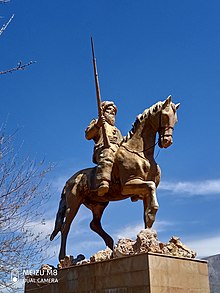Muhammad Pasha of Rawanduz

Muhammad Pasha of Rawanduz (Kurdish: میر محەممەد پاشای کۆرە, romanized: Mîr Mehemedê Rewandizî; also known as Mirê Kor - the "blind prince"; born in Rawandiz; 1783–1838) was Kurdish Mir of the Soran Emirate (1813–1838).[1][2][3] He conquered a large amount of Kurdish cities in the Ottoman Empire before being defeated and going missing.[4] Muhammad Pasha of Rawanduz was repeatedly responsible for massacres of the Yazidis. In 1832, thousands of Yazidis were killed in the Shekhan area by Muhammad Pasha of Rawanduz in cooperation with the Kurdish Botan prince Bedir Khan Beg.[5][6]Emir Muhammad Kor, who reigned from 1813 to 1836. His father, Mustafa Beg , peacefully handed the princedom to him. In the first few years of his rule, he consolidated his power and began launching attacks toward the neighboring principality of Baban . He occupied Harir in 1822, Koy Sanjaq , Altunkupri , Erbil in 1823, Akre , Ranya in 1824.[6] This established the Zab river as the border between the two emirates.
As the region experienced a power vacuum due to the decline of Baban, the Russo-Turkish War from 1828 to 1829, and the Egyptian–Ottoman War from 1831 to 1833, he led a tribal force to Rawandiz and built a citadel in the town as they build up a military. Between 1831 and 1834 he was able to capture several towns and cities in other Kurdish emirates. 1831 he captured the Bahdinan emirate of Amedi.[9] Kor further expanded his influence to Mardin , Cizre and Nusaybin , compelling the ruler of the Bohtan Mir Sevdin, to accept his authority, which caused serious concern in the Ottoman capital Constantinople.[9] Kor then captured Akre and oppressed Yazidis in the newly-conquered areas.[9]
Under Emir Kor, the Soran emirate developed a powerful army. It consisted of between 30 and 50,000 tribal musketeers who were given regular salaries, having the appearance of a national army.[6] Kor himself ate each evening with 100-200 soldiers from different tribes.[6] A multitude of different tribes joined his army such as the Baliki , Rewendek, Sidek, Shirwani, Rusuri, Malibas, Muzuri , Sheikhab, Nurik, Kheilani, Khoshnaw, Hnearai, Herki, Barzanji, Kassan, Derijiki, Bamami, Sekw, Shikuli, Mendik, Baimar, Balak, and Piraji with Kor's influence reaching almost every part of modern day Greater Kurdistan.
Fearing a cooperation between the Soran Emirate and Muhammad Ali of Egypt , the Ottomans dispatched an army to Soran in 1834. Mire Kor was able to repeal the forces and push towards Iran.[9] This led Kurdish notables from Bradost, Akre and Amedi to complain to Reşid Mehmed Pasha of the Ottoman government alleging they were oppressed by Mir Kor of Soran.[9]
Kor tried to subdue the Assyrians of Tyari in 1834 but suffered a defeat near the village of Lezan in Lower Tyari due to the Ottoman backing of Assyrian tribes and the betrayal of tribal chiefs. This defeat played a major role in the downfall of the emirate.[10][11][12][13] A second Ottoman offensive was initiated in 1836 which forced Kor to retreat to Rawandiz, again due to the lack of support from his tribal allies.[14]
After holding out in Rawandiz for several months, Emir Kor travelled to Istanbul for negotiations, where he was given authority over the area of the Emirate of Soran. But on his way home he disappeared in the Black Sea area and the Ottoman Empire supported his brother Rasul as the Emir of the Emirate. The Emirate would ultimately fall victim to the growing centralization of the Ottoman Empire.[15][16
[7][8][9][10]
See also
[edit]References
[edit]- ^ NEBEZ, Jemal (2017-08-14). Der kurdische Fürst MĪR MUHAMMAD AL-RAWĀNDIZĪ genannt MĪR-Ī KŌRA: Ein Beitrag zur kurdischen Geschichte (in German). epubli. ISBN 978-3-7450-1125-8.
- ^ Jwaideh, Wadie (2006-06-19). The Kurdish National Movement: Its Origins and Development. Syracuse University Press. ISBN 978-0-8156-3093-7.
- ^ Ate, Sabri; Ateş, Sabri (2013-10-21). Ottoman-Iranian Borderlands: Making a Boundary, 1843-1914. Cambridge University Press. ISBN 978-1-107-03365-8.
- ^ Behrendt, Günter (1993). Nationalismus in Kurdistan: Vorgeschichte, Entstehungsbedingungen und erste Manifestationen bis 1925 (in German). Deutsches Orient-Institut. p. 166. ISBN 3-89173-029-2.
- ^ Steinvorth, Daniel (2016-12-22). "Jagd auf den Engel Pfau | NZZ". Neue Zürcher Zeitung (in Swiss High German). ISSN 0376-6829. Retrieved 2020-12-20.
- ^ Acikyildiz, Birgul (2014-08-20). The Yezidis: The History of a Community, Culture and Religion. I.B.Tauris. ISBN 9781784532161.
- ^ Aboona, Hirmis (2008). Assyrians, Kurds, and Ottomans: Intercommunal Relations on the Periphery of the Ottoman Empire. Cambria Press. p. 173. ISBN 978-1-61336-471-0.
- ^ Ross, Mosul, 19 November 1847. From Ross to Layard, 61,63,79
- ^ Ross, Henry James (1902). Letters from the East. J. M. Dent & Company. pp. 62–63.
- ^ Laurie, Thomas (1853). Dr. Grant and the Mountain Nestorians. Gould and Lincoln. p. 262. ISBN 978-0-7905-5103-6.
- 1783 births
- 1838 deaths
- Political people from the Ottoman Empire
- Kurdish politicians from the Ottoman Empire
- Kurdish people from the Ottoman Empire
- 19th-century military personnel
- 18th-century Kurdish people
- 19th-century Kurdish people
- Kurdish people stubs
- Ottoman Empire people stubs
- Middle Eastern royalty stubs
